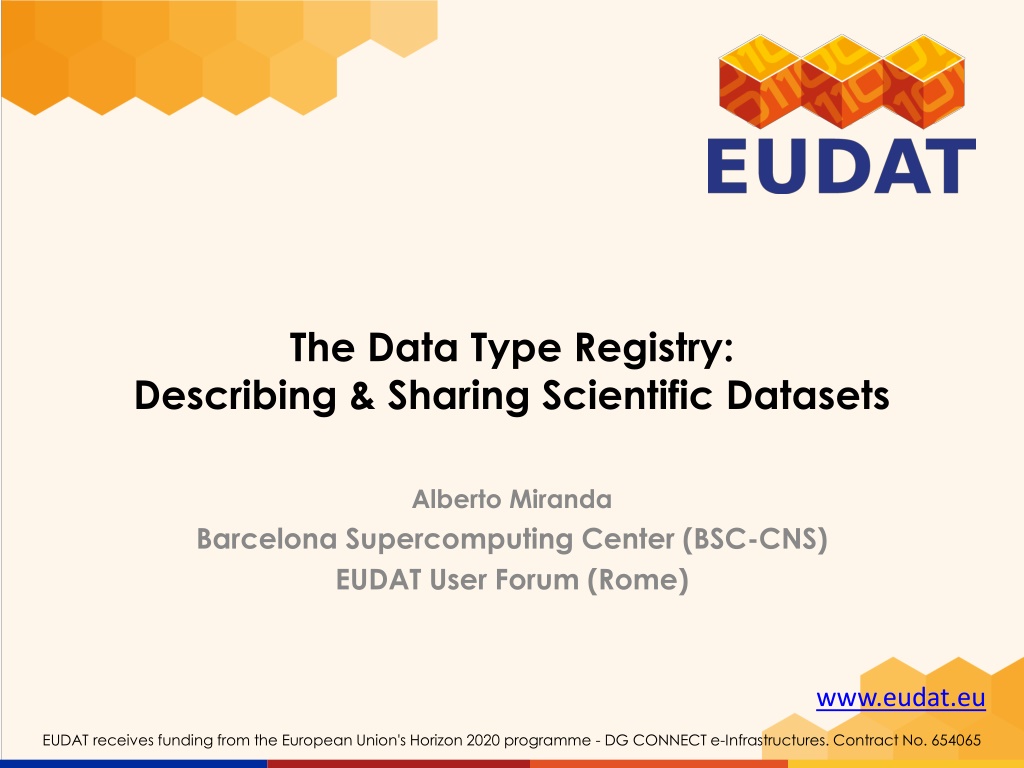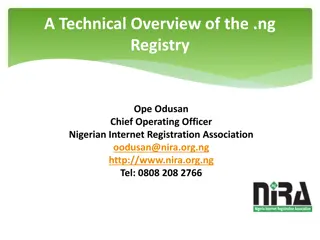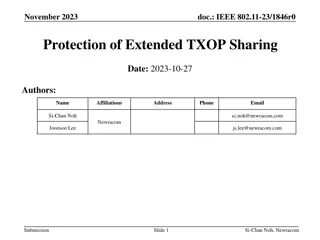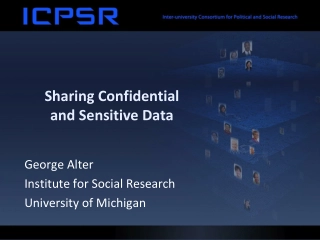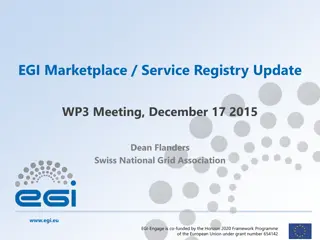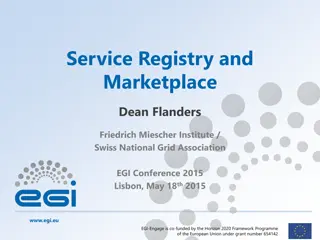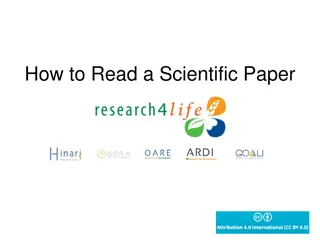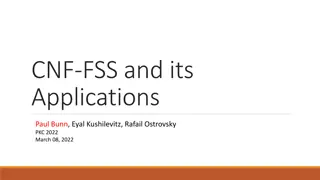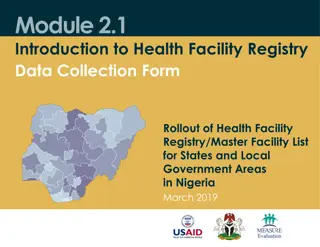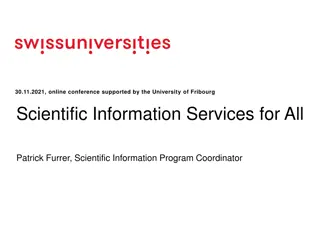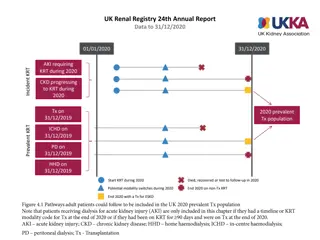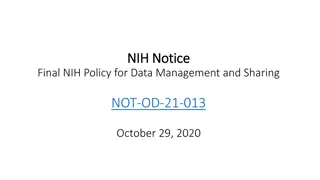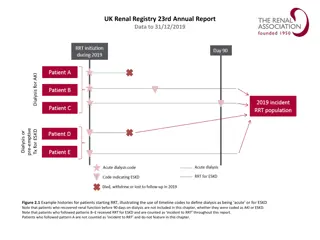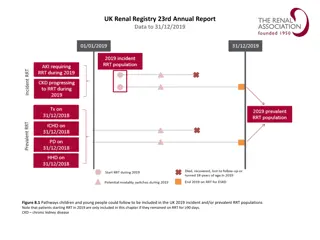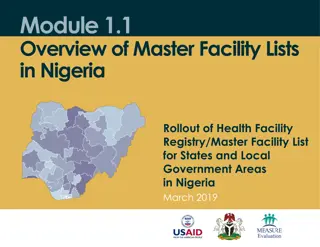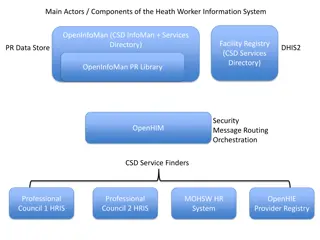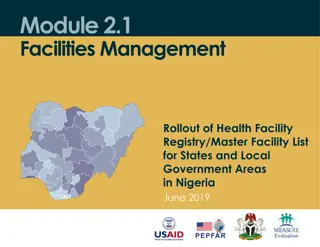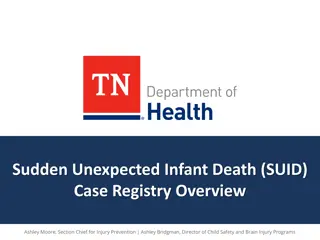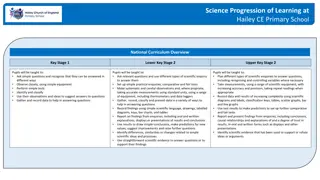Understanding the Importance of Data Type Registry in Scientific Data Sharing
Describing and sharing scientific datasets can be challenging due to the complexity and implicit assumptions involved. The Data Type Registry (DTR) addresses this issue by providing a systematic approach to define and record data assumptions, making data more accessible and reusable. Through DTR, data producers can ensure that important details like measurement units, variable names, and coordinate systems are documented for better understanding and interpretation by external users and applications.
Download Presentation

Please find below an Image/Link to download the presentation.
The content on the website is provided AS IS for your information and personal use only. It may not be sold, licensed, or shared on other websites without obtaining consent from the author. Download presentation by click this link. If you encounter any issues during the download, it is possible that the publisher has removed the file from their server.
E N D
Presentation Transcript
The Data Type Registry: Describing & Sharing Scientific Datasets Alberto Miranda Barcelona Supercomputing Center (BSC-CNS) EUDAT User Forum (Rome) www.eudat.eu www.eudat.eu EUDAT receives funding from the European Union's Horizon 2020 programme - DG CONNECT e-Infrastructures. Contract No. 654065
The Problem Understanding scientific data and metadata is hard Researcher 1: Could you tell me what column 12 means in the CSV file you referenced in paper A from 5 years ago? Researcher 2: Uh, I believe it s a number R1: I can see that. Could it be a temperature? R2: Probably R1: Fahrenheit? Celsius? R2: Maybe Kelvin or Rankine? R1: Kelvin? R2: On second thought, maybe it s not really a temperature R1:
The Problem Automatically analyzing and processing scientific data and metadata is even harder What is sequence 00010101010001001011110 ? It could be an integer how many bits? It could be a floating point number precision? It could be a string encoding? Even if we knew: What does it represent?
The Problem Data producers don t always specify certain implicit assumptions of the data Measurement units, reference coordinate systems, variable names,
The Problem Data producers don t always specify certain implicit assumptions of the data Measurement units, reference coordinate systems, variable names, But sharing requires data can be parsed, understood, and reused by external people and/or applications For documents MIME formats often enough, e.g. PDF Doesn t work well with data: what does number 42 mean in cell L36?
The Problem Data producers don t always specify certain implicit assumptions of the data Measurement units, reference coordinate systems, variable names, But sharing requires data can be parsed, understood, and reused by external people and/or applications For documents MIME formats often enough, e.g. PDF Doesn t work well with data: what does number 42 mean in cell L36? Thus, a systematic approach is needed to precisely define, specify and record these assumptions Accessible by users not involved in data production
What is a Data Type Registry? A DTR is a low-level service/infrastructure with the ability to record and disseminate Data Type Records
What is a Data Type Registry? A DTR is a low-level service/infrastructure with the ability to record and disseminate Data Type Records But, What is a Data Type?
What is a Data Type? A Data Type is a characterization of data at any level of granularity From small individual observations to large structured datasets Must include information about structural organization, contexts and assumptions in the data Cell A3 is a number, but is it a temperature? Celsius? It s a dataset, but what are the variable names? Is it packed as CSV/NetCDF? A single unit? A collection? Must be permanently linked to the described data Should be standardized, unique and discoverable
What is a Data Type Registry? A DTR is a low-level service/infrastructure with the ability to record and disseminate Data Type Records Minimum requirements: Should assign unique and resolvable identifiers to created/stored Data Type records Should enforceandvalidate a common datamodel for describing Data Types and their structure Should allowinteroperability between multiple instances Should offer a UIforhumanuse Should offer an API formachineuse
EUDATs DTR: Current Features Based on CNRI s Digital Object Repository and Registry software CORDRA + EPIC handles Well-tested, active, stable and open source Definition of primitive and derived Data Types (via composition of primitive types) Data Types are assigned unique and resolvable EPIC handles for persistent identification and retrieval Data Types are validated against pre-configured JSON schemas Data Types are indexed to allow content-based queries
EUDATs DTR: Current Features Access control policies to allow highly-controlled sharing and access restriction Data Type versioning REST API over HTTP and DOIP interface over TCP for machine-to-machine communication Web UI for humans to create, retrieve, update, delete, and search records using web browsers Federates Data Types across other Cordra instances while honoring access control policies
Data Type Example General: identifier: 11314.3/6debc53338e99ff15731 name: Stream Gauge description: Information that defines stream discharge at a specific location and time interval. Useful for the geosciences community. Standards: issued by: ISO ; name: 4375:2000 ; nature of applicability: depends Provenance: contributors: identified using: Text ; name: Mostafa Elag ; details: Researcher in the geosciences community identified using: Text ; name: Giridhar Manepalli ; details: Data infrastructure expert from CNRI creation date: 2014-08-07T04:25:10.798Z last modification date: 2014-09-06T20:06:28.410Z Expected Uses: Used for comparing outputs of surface runoff discharge models as applied to data pertaining to a specific watershed. Representation and Semantics: expression: Measurement Unit ; value: Cubic Meter per Second Properties: name: value ; identifier: 11314.3/f0f2c4382dcf8d257462 ; Type: Discharge name: coordinate ; identifier: 11314.3/4102c3ebe68bed21d644 ; Type: GPS Coordinate name: timestamp ; identifier: 11314.3/6386f4ebd23e9baace50 ; Type: Time Segment
DTR Examples: Processing Use Case 3 Users 2 Federated Set of Type Registries 1 4 ID ID ID Terms: ID 4 Type Type ID Type Type ID I Agree 10100 11010 101 . Data Set Dissemination Visualization Payload Payload Payload Type Payload Payload Payload Type Rights Data Processing Typed Data Services 1 Clients (processes or people) encounter an unknown type 2 The Type is resolved to the Data Type Registry 3 Response includes type definitions, relationships, properties, and possibly service pointers. Response can be used locally for processing, or, optionally 4 Typed data or references to typed data can be sent to service provider Source: Data Types Giridhar Manepalli, RDA 2nd Plenary
DTR Examples: Discovery Use Case 2 Users 1 Federated Set of Type Registries 3 4 ID ID ID ID Type Type ID Type Type ID Payload Payload Payload Type Payload Payload Payload Type Repositories and Metadata Registries 1 Clients (process or people) look for types that match their criteria for data. For example, clients may look for types that contain location and temperature information 2 Data Type Registry returns matching types. Weather-type is returned in our example 3 Clients look up in repositories and metadata registries for typed data (about weather-type) 4 Appropriate (weather) typed data is returned Source: Data Types Giridhar Manepalli, RDA 2nd Plenary
EUDAT Plans for the DTR Ongoing: Testing instance deployed at BSC To be used by beta-testers (more on this in a moment) Ongoing: Produce user/administrative documentation Starting: Integration with B2ACCESS Authentication/Authorization Infrastructure Starting: Integration with B2SHARE Integrate B2SHARE s metadata templates/keys in the DTR Allow users to include DTR Types within B2SHARE s interface Allow users to refer back to B2SHARE from DTR Types Starting: EUDAT branding Future: Depending on beta-testers feedback and CDI evolution (e.g. replace EPIC with B2HANDLE?)
DTR Beta-Testing Instance DTR s position in the CDI needs to be precisely defined How are communities going to use it? How is it going to relate to other services? How should use cases evolve to match the CDI? How should the CDI evolve to match use cases? The Data Type Schema needs to evolve to fit use cases from research communities We need to know what end-users need Initial beta-testers: ICOS and CLARIN Some Data Pilots also need Data Typing Beta-testers should usethe service, provide feedback and help define requirements
Q&A www.eudat.eu www.eudat.eu
